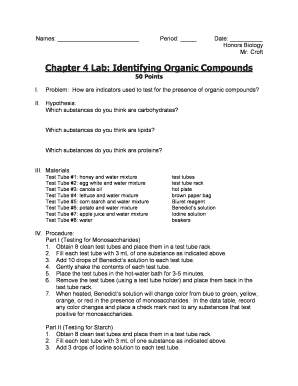Loading

Get Chapter 4 Lab: Identifying Organic Compounds - Bu
How it works
-
Open form follow the instructions
-
Easily sign the form with your finger
-
Send filled & signed form or save
How to fill out the Chapter 4 Lab: Identifying Organic Compounds - Bu online
This guide provides a comprehensive overview of how to complete the Chapter 4 Lab: Identifying Organic Compounds - Bu form online. Follow these instructions to ensure all necessary information is accurately filled out and submitted correctly.
Follow the steps to complete your lab form accurately.
- Press the ‘Get Form’ button to access the Chapter 4 Lab: Identifying Organic Compounds - Bu form.
- Begin by entering your name, period, and date at the top of the form. Ensure that this information is accurate to avoid any confusion regarding your submission.
- In section I, state the problem concerning how indicators are used to test for organic compounds. This should be a clear sentence.
- Proceed to section II, where you will write your hypothesis. Specify which substances you predict are carbohydrates, lipids, and proteins. Clearly identifying your predictions is important.
- In section III, list all materials required for the lab. Ensure that all items are included and properly formatted, as this section serves as a reference for your experiment.
- In section IV, outline the procedure for testing each type of organic compound. You may break this down into subsections for each test. Include steps for testing monosaccharides, starch, proteins, and lipids, as detailed in the document.
- Document your results in section V. Create a data table to record your observations regarding the presence of monosaccharides, starch, proteins, and lipids for each substance tested.
- In section VI, provide a comprehensive conclusion. Summarize your experiment, analyze the data collected, and discuss any potential errors that might have occurred during testing.
- Answer the questions listed in section VII in complete sentences. Ensure clarity and precision in your responses to demonstrate your understanding of the lab and its findings.
- After completing all sections of the form, save your changes. You may also download, print, or share the form as needed for submission.
Complete your Chapter 4 Lab: Identifying Organic Compounds - Bu online today to enhance your understanding of organic compounds.
Most organic compounds making up our cells and body belong to one of four classes: carbohydrates, lipids, proteins, and nucleic acids. These molecules are incorporated into our bodies with the food we eat.
Industry-leading security and compliance
US Legal Forms protects your data by complying with industry-specific security standards.
-
In businnes since 199725+ years providing professional legal documents.
-
Accredited businessGuarantees that a business meets BBB accreditation standards in the US and Canada.
-
Secured by BraintreeValidated Level 1 PCI DSS compliant payment gateway that accepts most major credit and debit card brands from across the globe.


